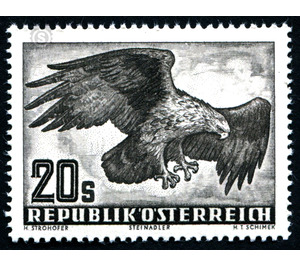birds - Austria / II. Republic of Austria 1952 - 20 Shilling
Theme: Animals
| Country | Austria / II. Republic of Austria |
| Issue Date | 1952 |
| Face Value | 20.00 |
| Color | black |
| Printing Type | Typography |
| Stamp Type | Air Post |
| Item Type | Stamp |
| Chronological Issue Number | 311 |
| Chronological Chapter | OOS-OE2 |
| SID | 901519 |
| In 34 Wishlists | |
2. Air mail series "Vogelflug" - Golden Eagle There was no need for an air mail series, but the post office wanted to follow the tradition of the prewar period, when a series of airline stamps had appeared simultaneously (eg 1925 and 1935). The designer Prof. Hans Strohofer consciously dispensed with the then customary framing of the brand image in his designs to indicate the vastness and "boundlessness" of the sky. Golden Eagle: The golden eagle is a large species of raptor within the family of hawk-like. It inhabits open and semi-open landscapes and usually feeds on medium-sized, bottom-dwelling mammals, while he is extremely strong and very skillful. He regularly captures animals that are considerably heavier than himself. The maximum prey weight is around 15 kilograms. The species used to be widespread in Europe, but was systematically persecuted, so that today it only occurs in mountainous areas in many parts of Europe. In Central Europe, golden eagles only breed in the Alps. The wingspan varies between 190 and 210 cm in the male and between 200 and 230 cm in the female. 7.1.1952: 7. Value 20S: Golden eagle 1st edition: grayish, soft paper with yellow gum 6 April 1956: The end of the airmail stamps: With instructions from the General Postdirektion, all airmail stamps were declared postage stamps and released at franking for all postal items. The fact that Austrian Airmail stamps were in the past only permitted for the franking of air mail items had occasionally given rise to errors. 24.6.1959: new edition: a) white, brittle paper with white, matt glossy adhesive coating b) grayish, brittle paper with a gray, matt adhesive coating Balloon mail was NOT considered an airmail: When the first balloon mail was granted to the Austrian Children's Village Association in 1948, Austria was not allowed by the allied victorious powers to operate an airmail in its independent sphere of influence. However, in order to be able to set up the balloon post at all, the PT established that this mailing was not an airmail, because the authorization of the Allied occupying powers would have had to be obtained for this purpose. The balloon mail was therefore declared to interest post offices, whereby it was left to the organizers, with which means of transport the mail was carried. A parallel case to these balloon items was the Segelflugpost 1950 from Graz on the occasion of the jubilee exhibition "100 Years Stamp". Consequently, the use of airmail stamps for these mailing operations was also inadmissible, except in the case of airmail being forwarded. The airmail surcharge was credited to the country, whose aircraft then transported the post. The only exception was the 4th balloon mail on 21.10.1950, which was also the first day of the first two airmail stamps of this series (60 g and 2.-S), as by an "erroneous interpretation" of the then new provisions also for the domestic addressed balloon mail items airmail stamps were accepted for franking. This was immediately banned by a separate disposition for all subsequent events.


